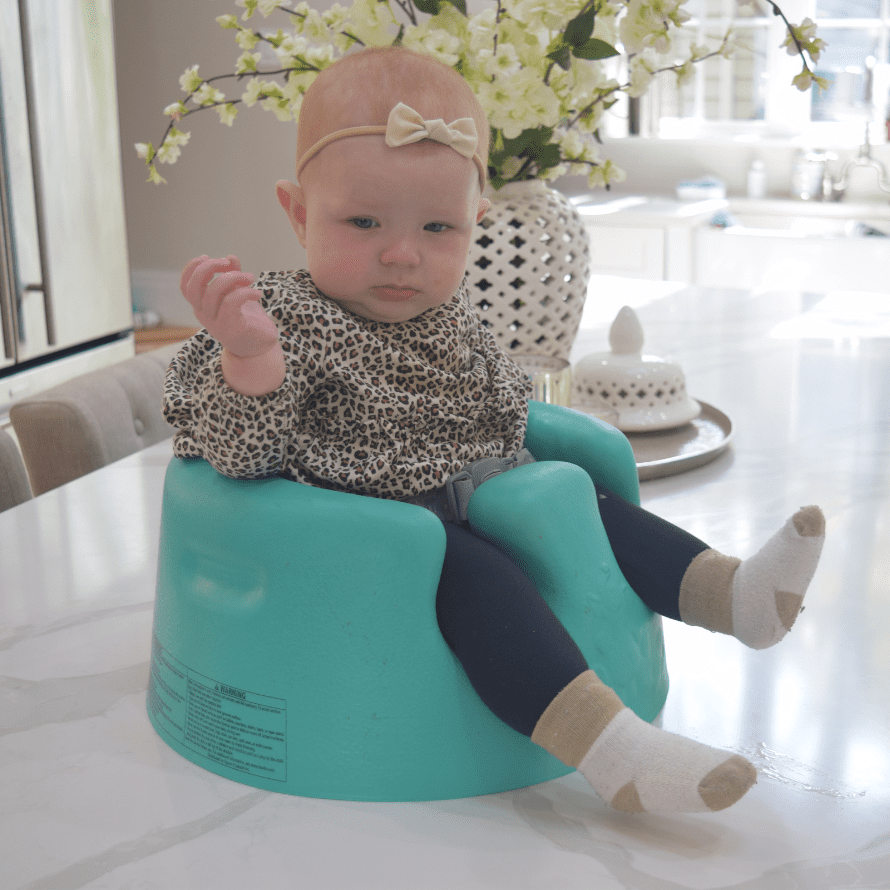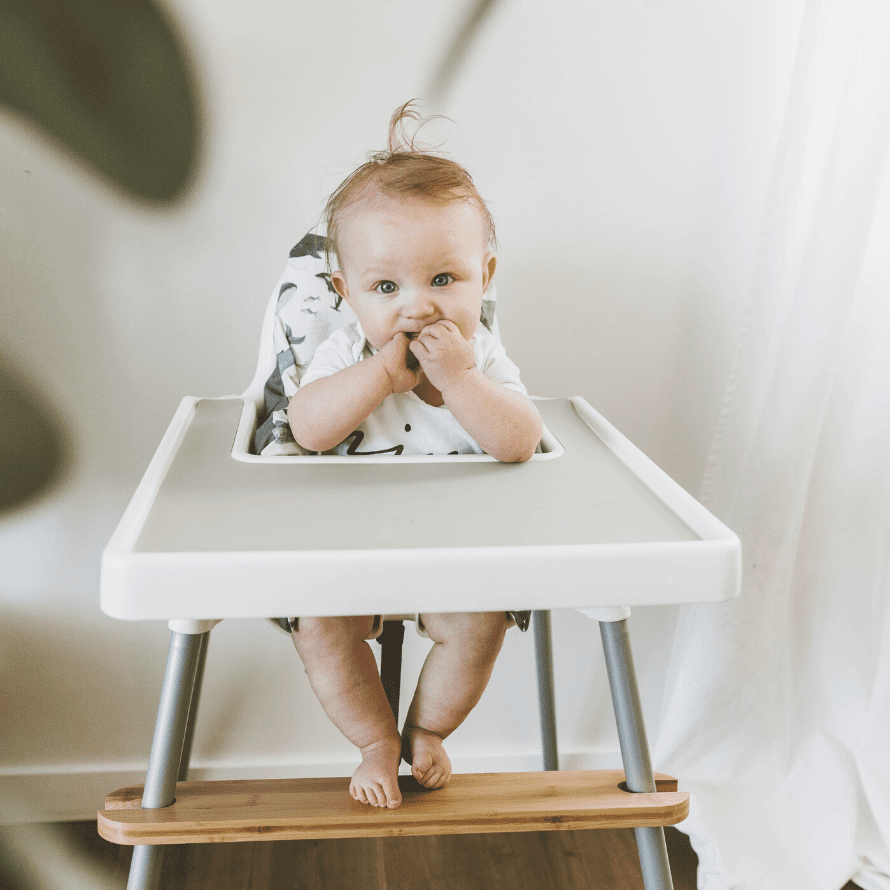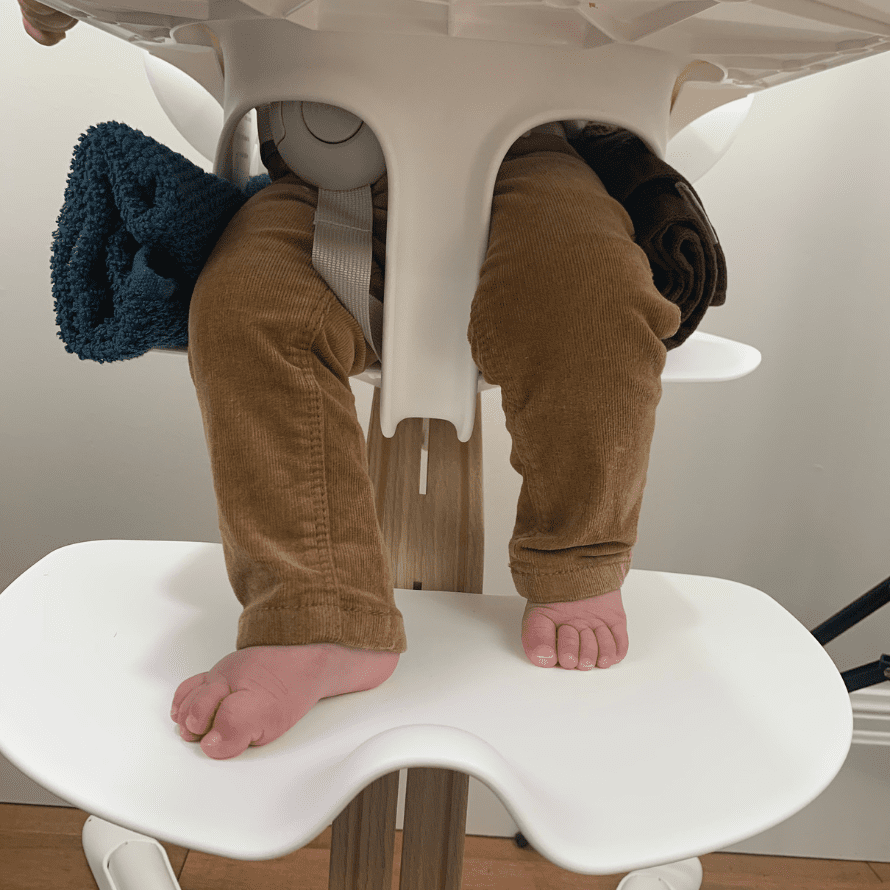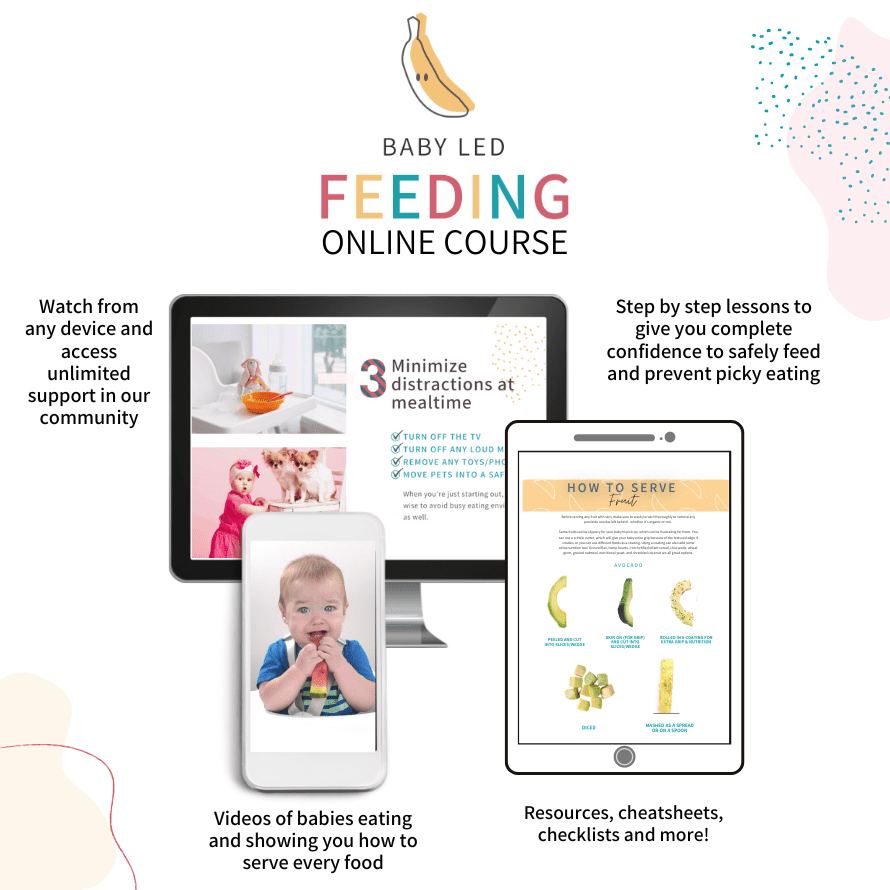I’m sure we’ve all done our fair share of browsing for the best baby led weaning high chair, looked at the different styles, and wondered if the real expensive ones are actually worth it.
We might be browsing a lot of options, or have specific wants in mind. Maybe we’re looking at a toddler chair, a booster seat, a wooden high chair, or even a dining room chair that works with a booster seat we already have.
The fact is, we know our baby needs someplace they can safely sit to eat when starting solid foods – they obviously can’t just sit in a regular chair!
But did you know that there is an optimal position for feeding? Or that your baby needs to be able to sit upright independently for starting solids? Tip one: skip the high chair that reclines!
Let’s go over all you need to know about high chair positioning for your little eater. And know that whether you choose to start with purées or baby led weaning – my tips are the same!

Table of Contents
One of the readiness signs for starting solids is that your baby can sit up in a proper sitting position, independently. This is true whether you decide to start with purées or baby led weaning. This usually happens right around 6 months of age, but can be different for every baby.
In my opinion, it’s probably THE most important sign of readiness, mainly because it’s the biggest indication that they can eat safely without a high risk of choking.
While safety is always my number one priority, being able to sit up independently also means that feeding will be more successful.
In fact, there are certain things that can be done with regards to positioning and support that actually help your baby advance in eating skills, stay in the high chair for longer, remain comfortable, and enjoy the process so much more.
But most parents that are just starting their baby led weaning journey are confused by what this actually means. Does this mean they have to be sitting upright for a certain period of time? Should I set a timer to see how long? How “independent” are we talking here (AKA can I support them in any way)? What if they topple over after a couple minutes?
These are all very valid questions.
Let’s start by explaining what the best position for starting solids is (for both baby led weaning and purées), and why it’s important.
The best position for starting solids with baby led weaning or purées

No matter what the particular high chair is that you choose to use, these are the key points you need to assess for, in order to ensure your baby is seated properly and safely. Therefore, the best position for starting solids with purées and baby led weaning, is one that allows your baby to:
- Hold their head up straight and steady independently, without tiring themselves
- Sit at a right angle where their bum and pelvis are positioned directly under their hips
- Sit with their torso upright so their airway is unrestricted (no reclined positioning in the high chair needed)
- Have their shoulders positioned just slightly in front of the hips
- Have their arms unrestricted and free to move
- Be able to lean forward, and turn slightly to the left or right without major restriction
- Have feet supported with an adjustable foot rest
Alright, now let’s break down the reasons for all this.
Proper high chair positioning begins with allowing for independent head, neck and trunk control

First off, does your baby have the ability to hold their head up nice and still, independently, or do you have to support them?
If you have to support them at all, your baby is definitely not ready to start using a baby high chair (or begin eating solid food).
Even the most supportive high chair would require a reclined position for a baby that cannot hold their head up independently, and as we know now, that is not recommended.
Independent head control decreases choking risk
It’s important that your baby can hold their head steady and be able to sit upright with good trunk stability, so they can safely eat without running a high risk of choking on their food.

This is also why I mention that proper high chair positioning cannot include reclined positions, as this would give support to your baby’s head and neck, creating a false sense of security.
Yes, your baby’s head will be still, BUT their airway is not completely open in this position, and a reclined position puts them at more of a risk for choking. That’s why this is not a position for baby led weaning or for purée feeding.
Head control also means they have more fine motor skills to successfully eat
The gross motor skill of holding their head, neck, and torso up steadily is needed in order for your baby to be able to practice their fine motor skills (like chewing, picking up objects, scooping with a spoon, etc.).

Without it, it would be very difficult to eat!
Think about if you were to slouch back in a chair and have your head hanging over to one side or down low. It would be near impossible to eat properly – let alone learn how to do it for the first time!
As my good friend and speech language pathologist Catherine at ChiKids Feeding says, “Stability at the hips = success at the lips!”. Independent movement of the jaw, lips, and tongue (which is absolutely key to being able to learn how to chew and move food around in the mouth) only happens when your baby develops the strength to hold their head, neck, and torso up first.
It’s a sequential developmental process, so waiting for one to happen in order for the other to happen, is necessary.
Stages of development required for safe eating in high chairs

The best position for starting solid foods is based on the 90-90-90 rule
As mentioned earlier, your baby needs to be positioned in a high chair in a way that keeps their bum directly under their hips, and their shoulders slightly in front.
In addition to actually being successful at eating, having the head align over the shoulders and having the core strength to keep the torso upright and open, means your baby’s airway is open as well.
Therefore, food can be easily directed down the right pipe (esophagus), rather than the wrong one (airway)…thereby reducing the risk of choking!
Occupational therapists call this the 90-90-90 rule.
Meaning, your baby should have a 90-degree angle at their hips, a 90-degree angle at their knees, and a 90-degree angle at their ankles while sitting in an infant high chair for baby led weaning or purées.

This is why I would never recommend using a Bumbo floor seat for your baby at meal times (or for “helping” your baby sit).
Why?
Because when your baby sits in a Bumbo floor seat, take a look at your child’s posture, and specifically, how their head, neck, trunk, and pelvis are aligned.
Notice how their bum is positioned below and behind the hips, which compresses their torso (hello choking risk and regurgitation of food!), and constricts movements of their hands and body.

If you want to use a floor seat, or an infant positioning seat, to help your baby develop those core muscles that they need to be able to sit up independently, please opt for the Upseat over Bumbo floor seats.
The Upseat is designed with the help of physical therapists, and actually promotes proper upright posture, healthy hip development, and allows your baby to continue to move their upper body – crucial for feeding!
It does come with a removable tray as well, so you can use this seat for feeding, if you choose. When it comes to using a baby chair seat for practicing sitting independently, I’m always going to recommend the Upseat.
And, it’s safe to begin using from around 4 months when your baby has developed head and neck control, so you can start developing those necessary muscles to be ready for solids around 6 months of age!
I know that floor seats are so convenient for parents, and I genuinely love The Upseat so much that I did get a coupon code for you to use as well! Enter in code MYLITTLEEATER10 at checkout to receive 10% off your purchase.
High chair foot rest for foot support

Finally, babies should have their feet supported by some type of adjustable foot rest when eating in their baby led weaning high chairs. As you can see in the above image, the Ikea Antilop high chair has been modified to add on foot support because it really is so important.
Here’s why….
Think about if you were to eat off a really tall bar stool.
Ever notice how you automatically wrap your feet around the pole, or on a bar, to provide stability and comfort?
You wouldn’t be able to concentrate on a fine motor activity (like eating) if you had dangling feet with no support. And it would certainly be harder to maintain good posture and core strength.
Babies and toddlers are the same. Having no support for your baby’s feet means that it requires so much more focus to just sit up – let alone having to concentrate on learning a new task, like eating!
Unrestricted arm movement in baby led weaning high chairs

Speaking of restricting movement…when your baby sits, we want their arms to be unrestricted and for them to be able to lean forward, as well as for them to be able to angle their body ever so slightly to the left and to the right without feeling struggle or strain.
This is for a couple of different reasons:
1) Leaning slightly forward and having good range of motion with their arms, actually makes grabbing pieces of food easy for self-feeding.
2) Most babies can use their body language to communicate and tell us if they want more (they’ll lean in for a bite), if they’re full, bored, tired or don’t like it (they’ll turn away).
These are key communication strategies that are all part of allowing your baby to be an active participant in feeding (which allows us to be responsive to their needs) – a key factor in my Baby Led Feeding method.
A few tips for making sure you get proper high chair positioning
1. Make sure the back of the high chair is set to a fully upright position

NEVER FEED YOUR BABY IN A RECLINING POSITION (even if your blw high chair has this ability).
As I mentioned above, if they’re in a reclined high chair, they’re at an increased risk of having a piece of food get stuck in their airway and cause choking.
It’s also not very comfortable. Imagine if you had to do an ab crunch every time you wanted to lean forward and grab a piece of food!
2. Use a rolled up towel to fill in any gap between your baby’s back and the back of the high chair


If you find that even when they’re fully sitting upright in the blw high chair, your baby has a large gap between the back of the high chair and their back (see first photo above). Or, it still looks like they aren’t sitting in a 90 degree hip to torso position, placing a folded towel between the back of their shoulders and the high chair back works well.
This gives them support and makes it less work to eat by keeping them forward a bit (see second photo above). It could be way too uncomfortable, and tiring for them, to have to use all that core power to maintain an independent, upright position for an entire meal.
In the same way, if they’re bum is so far back in the seat in order to keep their back up against the back of the high chair, then every time they want to lean over and grab a piece of food, they’d be using lots of ab power – which is also exhausting.
Placing a towel in between their back and the high chair means they can still sit upright, but closer to the tray.
3. Use a rolled up towel to wrap around baby’s hips to support them and prevent them from sliding or toppling over



As you can see in the first photo above, this baby actually kept sliding forward in her baby led weaning high chair. This was fixed by wrapping a towel around either side of her hips to fill in the gaps on either side, and secure her more in place (seen in the second and third photos).
This is also a good trick to use if your baby gets tired after a few minutes of completely independent sitting, and starts to topple to one side or another.
Helping them sit with assists like this to help them last through the entire meal is totally fine, as long as they still have free range of motion in their torso and arms.
4. Ensure that your baby’s high chair tray is positioned about halfway between their belly button and the breast

Adjusting the high chair tray so that it’s positioned halfway between your baby’s belly button and breast will ensure that they can rest their elbows comfortably on the tray. This will allow them to reach for things easily, and gives their hands something to rest on during the meal.
5. Ensure there’s proper foot support on the infant high chair
This can either be from a high chair with built-in, adjustable high chair foot support, or you can set up your own using a cut pool noodle (see here). Or by attaching a tea towel across the bottom of your baby’s high chair (like this one here).
Babies eat so much better, and are way more comfortable, when they have something grounding them to help provide them with that core stability in their high chair.
Positioning your baby for feeding (in a nutshell)
To sum it all up, knowing when it’s safe for your baby to sit in a high chair really depends on their readiness to do so. Remember that this process can only be done when they’re developmentally ready, so don’t rush it!
And make sure that when your baby sits in a high chair, they’re sitting using the 90-90-90 rule, and never reclining backwards.
If you found the tips I gave here helpful, you’ll love all the tips I have for you on my Instagram page! And if you’re looking for a complete plan for how to feed your baby purées or finger foods, the baby-led way, take the Baby Led Feeding online course to walk you through everything you need to know, step-by-step!
Pin this for when you’re starting solids with your baby!







